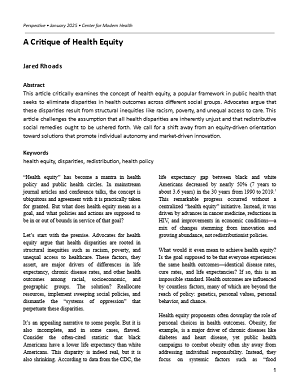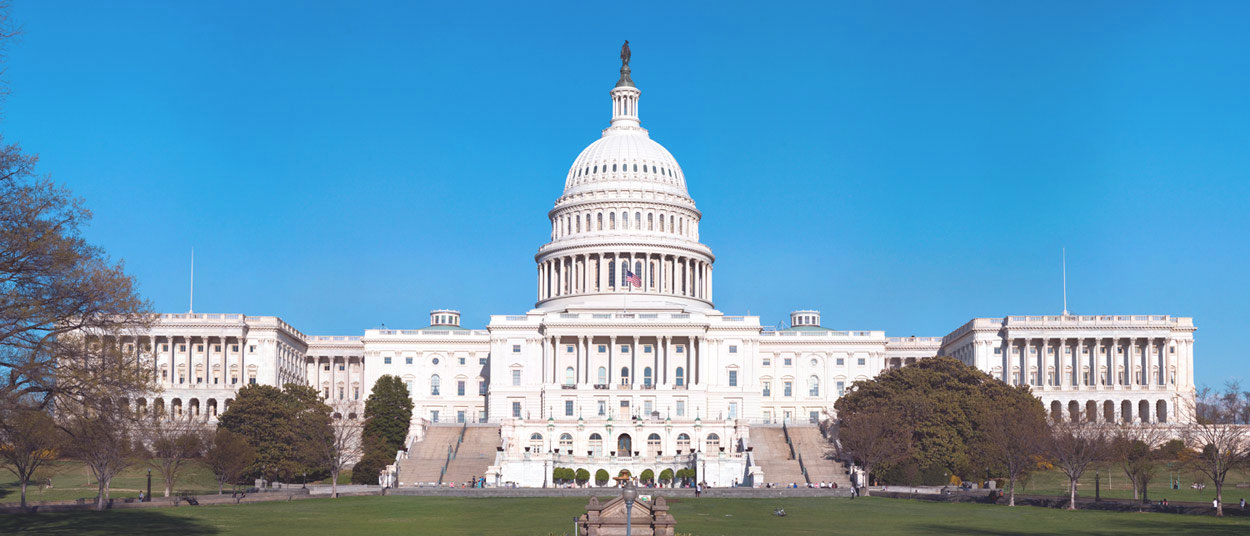A Critique of Health Equity
"Health equity" dominates the discussion in mainstream health policy and public health circles. But should it?
View/Download [PDF]
Rhoads, J. "A Critique of Health Equity." Center for Modern Health. January 2025.
"Health equity" has become a mantra in health policy and public health circles. In mainstream journal articles and conference talks, the concept is ubiquitous and agreement with it is practically taken for granted. But what does health equity mean as a goal, and what policies and actions are supposed to be in or out of bounds in service of that goal?
Let's start with the premise. Advocates for health equity argue that health disparities are rooted in structural inequities such as racism, poverty, and unequal access to healthcare. These factors, they assert, are major drivers of differences in life expectancy, chronic disease rates, and other health outcomes among racial, socioeconomic, and geographic groups. The solution? Reallocate resources, implement sweeping social policies, and dismantle the "systems of oppression" that perpetuate these disparities.
It's an appealing narrative to some people. But it is also incomplete, and in some cases, flawed. Consider the often-cited statistic that black Americans have a lower life expectancy than white Americans. This disparity is indeed real, but it is also shrinking. According to data from the CDC, the life expectancy gap between black and white Americans decreased by nearly 50% (7 years to about 3.6 years) in the 30 years from 1990 to 2019.1 This remarkable progress occurred without a centralized "health equity" initiative. Instead, it was driven by advances in cancer medicine, reductions in HIV, and improvements in economic conditions—a mix of changes stemming from innovation and growing abundance, not redistributionist policies.
What would it even mean to achieve health equity? Is the goal supposed to be that everyone experiences the same health outcomes—identical disease rates, cure rates, and life expectancies? If so, this is an impossible standard. Health outcomes are influenced by countless factors, many of which are beyond the reach of policy: genetics, personal values, personal behavior, and chance.
Health equity proponents often downplay the role of personal choices in health outcomes. Obesity, for example, is a major driver of chronic diseases like diabetes and heart disease, yet public health campaigns to combat obesity often shy away from addressing individual responsibility. Instead, they focus on systemic factors such as "food deserts"—areas with limited access to healthy food. However, research suggests that obesity rates are only weakly correlated with proximity to grocery stores. A 2014 study published in Health Affairs found that increasing access to supermarkets improved food accessibility but did not lead to changes in fruit and vegetable intake or body mass index.2 While it is true that one's environment influences one's behavior, personal choices also matter, and neglecting this reality does a disservice to those we aim to help.
What's more, not all health disparities are inherently unjust. Differences in health outcomes often reflect the diverse choices people make about how to live their lives. One person might prioritize fitness and a balanced diet, while another might value the pleasure of indulgence over the promise of longevity. Pursuing career accomplishments at the cost of all sport, recreation, and stress relief is another choice with non-trivial effects on health. These are personal decisions that ought to be respected in a free, liberal society. Using the government to attempt to eliminate all disparities risks trampling individual freedoms.
Some proponents of health equity don't interpret the concept as calling for equal outcomes. Perhaps recognizing the impossibility or political unpopularity of such a goal, they instead emphasize the idea of "equal opportunity." For instance, the Centers for Disease Control (CDC) and the Centers for Medicare and Medicaid Services (CMS) both define health equity as "when everyone has a fair and just opportunity to attain their highest level of health."3
This shift in emphasis toward equality of opportunity doesn't rescue the health equity project. Equality of opportunity is the idea that individuals can pursue their goals without unfair barriers. Although this represents better framing in some regards, it is still not without challenges. Defining what constitutes a fair opportunity can be contentious. Often the metaphor of a "starting line" or "starting point" is invoked, as if life is a race to be won. But life is not a competition, and the circumstances in which one person starts are shaped by the outcomes of other people in that person's life—e.g., the health, socioeconomic status, and educational attainment of one's parents. To prohibit parents from sharing with their children the life they have cultivated would be clearly unfair. The call for equal opportunity merely shifts the same unworkable premise into a new guise, leaving the underlying issues unresolved.
There are some disparities that should unequivocally be the concern of people in health policy: disparities directly created or perpetuated by government-sanctioned actions. If a law or regulation violates the rights of one group at the expense of another, that is a clear injustice demanding reform. For example, zoning laws that restrict the establishment of healthcare facilities in poorer areas or licensing requirements that artificially limit the supply of certain types of clinicians might create measurable disparities. Such policies directly harm those in need and they deserve immediate correction. Beyond addressing such state-imposed barriers, however, government intervention in pursuit of health equity is fraught with potential violations of individual rights and due process, and likely to fail.
Disparities that are not directly attributable to government actions can and should be taken up by nonprofits, social groups, and the like. There is nothing wrong with groups of individuals coming together to take an interest in helping a particular community or patient population through voluntary means (e.g., charity, business). Non-governmental, voluntary-funded efforts are additive, and they are in fact an expression of the freedom and values of those who get involved. Government policies, by contrast, are coercive and zero-sum. Behind government policy is force, and because government does not productively generate the wealth and resources that it deploys, that which it puts toward one priority cannot be put toward another.
As a matter of science, it is proper for epidemiologists and medical researchers to want to track and study the distribution of disease burdens and to take special interest in investigating unusual, unwarranted sources of variation. But the path forward in improving health lies not in obsessing over statistical parity but in fostering an environment where everyone has the freedom to act in the pursuit of health. This means supporting a more limited role for government, and policies promoting innovation, competition, and personal responsibility. It means addressing root causes without embracing the hollow ideal of "health equity" and the identity politics that tends to accompany it.
The ideological rigidity of the health equity movement blinds the movement to alternative, and likely more effective, approaches to improving health outcomes. Free-market systems have lifted billions of people out of poverty and driven innovations in medicine, nutrition, and sanitation. These advancements have improved health outcomes across the board, especially for the world's poorest people. A better strategy for achieving progress in health policy consists not in leveling outcomes but in ensuring individuals are not coercively prevented from acting to improve their lives.
References:
1. Schwandt, et al. "Inequality in mortality between Black and White Americans by age, place, and cause and in comparison to Europe, 1990 to 2018," Proc. Natl. Acad. Sci. U.S.A. 118 (40). (2021).
2. Cummins S, Flint E, Matthews SA. "New neighborhood grocery store increased awareness of food access but did not alter dietary habits or obesity." Health Aff (Millwood). 2014 Feb;33(2):283-91.
3. See, for example, "What is Health Equity?" CDC. https://www.cdc.gov/health-equity/what-is/index.html. Accessed December 29, 2024. And "Health Equity" CMS. https://www.cms.gov/pillar/health-equity. Accessed December 29, 2024.
